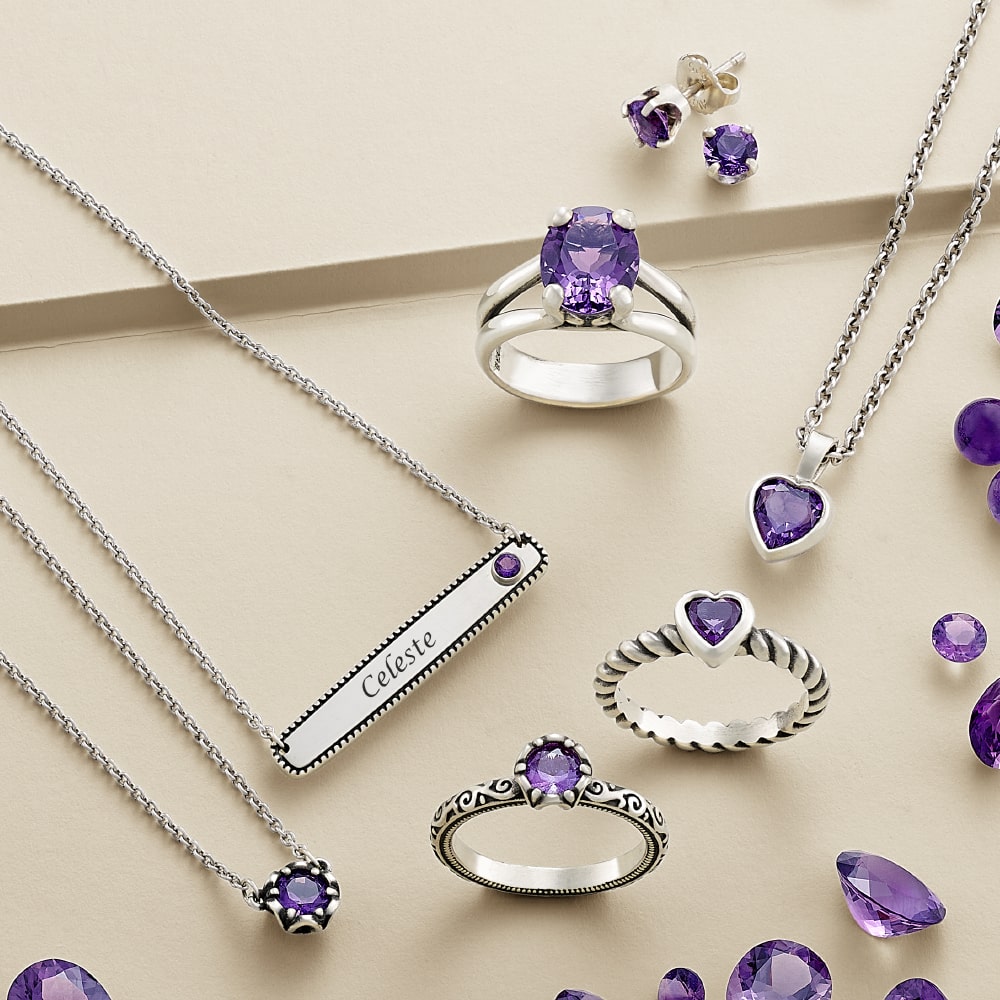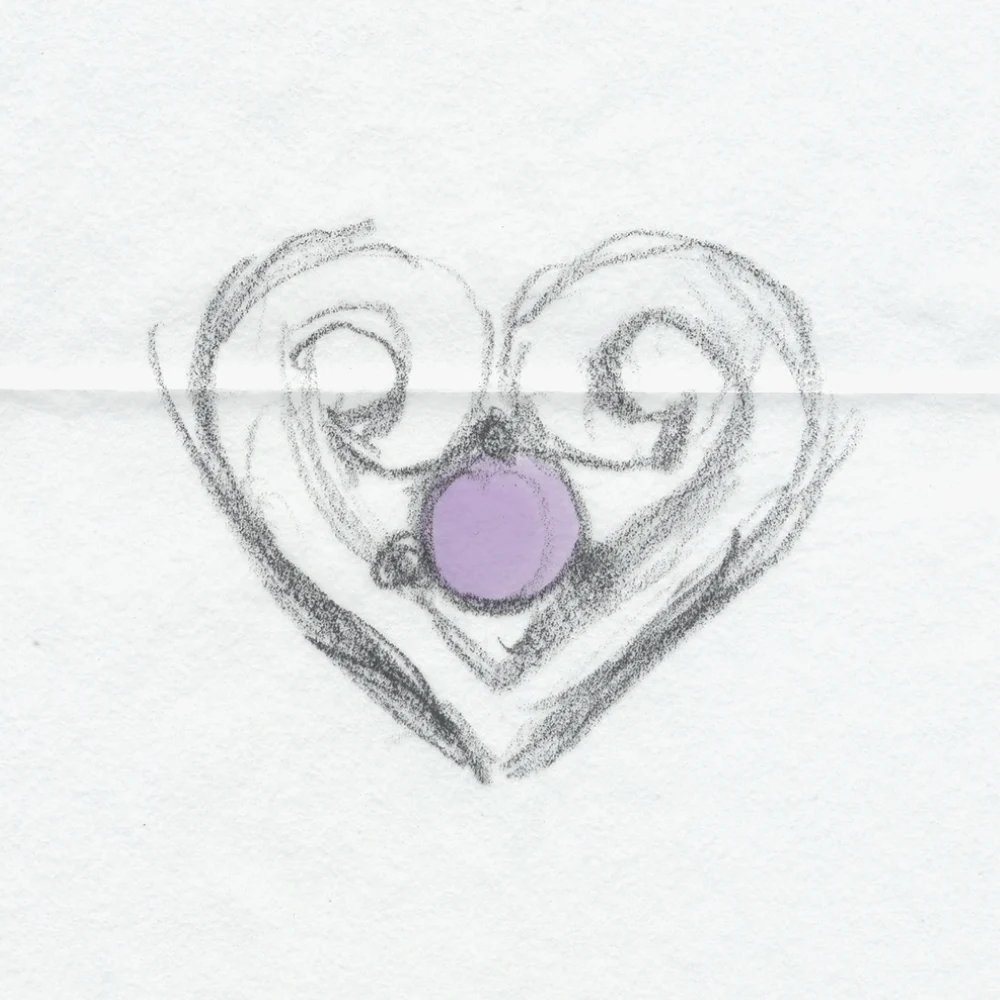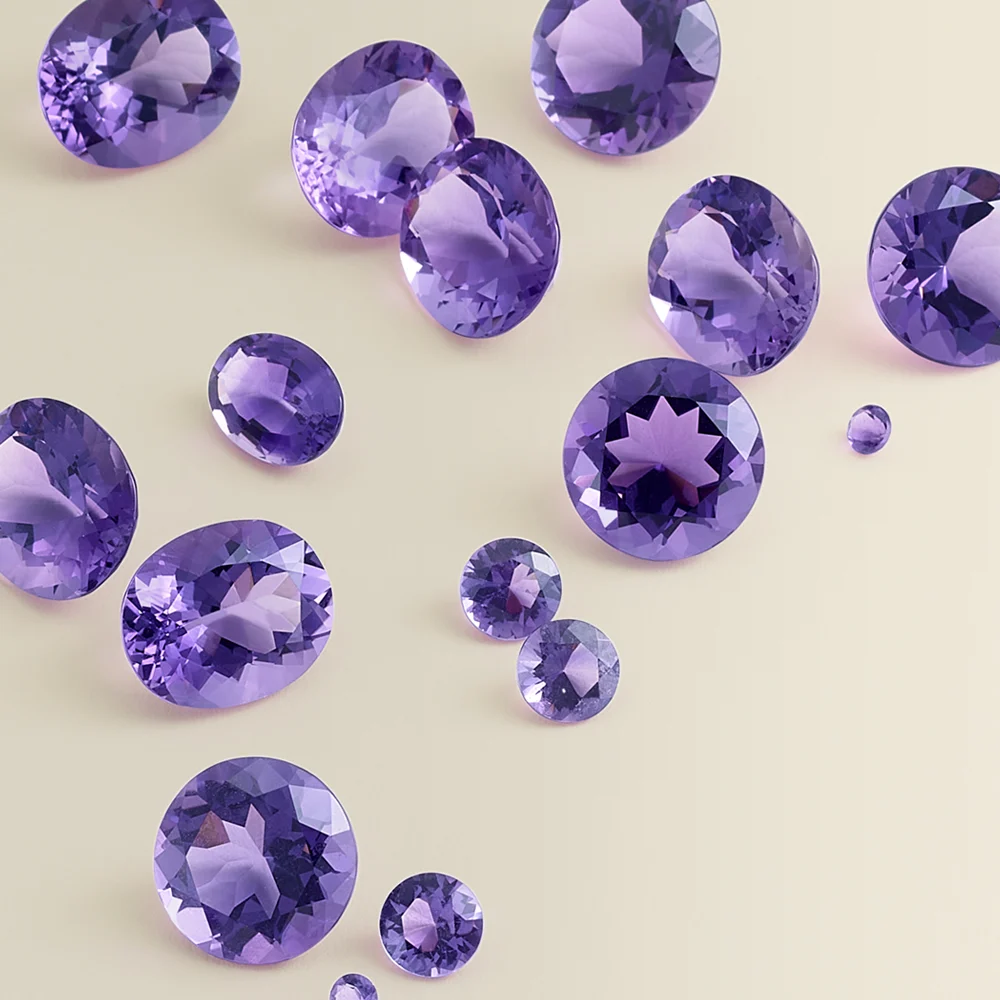February Birthstone

The magic and appeal of birthstones lie not just in their beauty but in the stories they tell and the significance they hold. The February birthstone, the amethyst, is no exception.
With its striking violet hue, this majestic gem has been cherished for centuries, adorning royal crowns, treasured artifacts and modern jewelry collections alike. Amethyst is a symbol of serenity, strength, and personal clarity, combining the mystique of ancient civilizations and the elegance of contemporary design.
As we delve deeper into the world of this captivating gemstone, we'll uncover its origins, its myriad of shades, its rich history, and its enduring place in modern jewelry trends. Whether you're born in February or simply enamored by the amethyst's unique beauty, this guide will showcase this gem's many facets.
What is February’s Birthstone?

Amethyst holds the honor of being the birthstone for February. This variety of quartz is distinguished by its mesmerizing shades of violet and purple colors.
The gemstone’s allure goes beyond its famously vibrant hue; its associations with tranquility, clarity, and protection have made it a favorite across generations. Rooted in ancient traditions and still cherished in contemporary jewelry designs, the amethyst remains a popular choice for those born in February and many others drawn to its enduring charm.
The Amethyst Birthstone
As a member of the quartz family, this gemstone carries with it a legacy of elegance and a range of colors that speak to its depth and versatility. From light lilac hues to the deep purples reminiscent of a twilight sky, amethyst is a stone that inevitably catches the eye.
What Color is Amethyst?
The color palette of amethyst is surprisingly diverse. Typically recognized for its iconic purple colors and hue, the shades of amethyst span from soft lavenders to rich, regal purples. The purpose of an amethyst birthstone can be a cool, almost bluish tone, a reddish purple (nicknamed “raspberry”), or anywhere in between.
Amethyst Shades and Varieties
The varied shades of Amethyst are due to the presence of iron and other trace elements during each gemstone’s formation. Some amethysts even showcase gradients within a single gem, transitioning from deep violet at one end to a subtle lavender at the other, creating a spectrum that you simply won’t see in any other birthstone. This is a characteristic known as “color zoning,” and it only adds to the distinct beauty of the amethyst crystal.
Amethyst Birthstone Meaning and History
 Amethyst carries a profound legacy, one that interweaves history, mythology, and spiritual practices. As we take a closer look at the origins and significance of this magnificent stone, we'll discover its geographical roots, its place in ancient societies, and the deep meanings attributed to it over the millennia.
Amethyst carries a profound legacy, one that interweaves history, mythology, and spiritual practices. As we take a closer look at the origins and significance of this magnificent stone, we'll discover its geographical roots, its place in ancient societies, and the deep meanings attributed to it over the millennia.
Where is Amethyst Found?
Amethyst is scattered across various parts of the world. The primary sources of this gem are Brazil and Uruguay, both renowned for their large, high-quality deposits. The amethyst mines in Brazil, especially in the states of Minas Gerais, Espírito Santo, and Bahia, are prolific producers. In these regions, the stone is often found inside volcanic rocks, showcasing brilliant colorations.
Africa, too, is a significant producer. Zambia, in particular, is known for its deep, saturated amethyst, while Madagascar's deposits offer stones with a lighter tone. North America isn't left behind, with Arizona in the US being a noted source, producing gems with a reddish undertone.
Russia once had a stronghold on the amethyst market, especially those sourced from the Ural Mountains, which were as prized as the famed Brazilian ones. However, in recent years, their prominence has diminished due to depleting resources.
History of Amethyst
Amethyst’s history is rich and spans numerous civilizations. Ancient Egyptians used it as a gem in their jewelry. The name "amethyst" itself originates from the Greek word “amethystos,” which means “not intoxicated.” This highly literal translation gets straight to the point: Ancient Greeks believed that this gem could prevent drunkenness. As a result, wine goblets were often embedded with amethysts, with the hope that the stone would prevent overindulgence.
Beyond its associations with wine, the stone held religious significance. In Christianity, it’s believed that Saint Valentine wore a gold ring adorned with an amethyst carved with an image of Cupid. This connection to Saint Valentine, along with its purple hue—which signifies purity and spirituality—has cemented amethyst's place in religious artifacts, especially those used by bishops and other clergy.
Romans, too, held the gem in high regard, using it in their intaglio engraved rings, while medieval European soldiers wore amethyst amulets as protection in battle, believing the stone had healing properties and could keep them cool-headed.
During the Middle Ages, amethyst retained its significance, especially in Europe. The gem was associated with many attributes, including piety, humility, sincerity, and spiritual wisdom. Its deep purple hue made it an ideal stone for rosaries and other religious artifacts. Monarchs and the nobility favored amethyst for their regalia because its rich color symbolized royalty and a close connection to the divine. Artisans and jewelers of the era often used amethysts to create exquisite pieces that reflected the stone’s elevated status in society.
The Victorian era was marked by extravagance and an inclination towards romanticism. Jewelry became a central medium of expression, and amethyst, with its royal hue and romantic aura, fit right in. Queen Victoria herself was fond of the gem, and her preference influenced the jewelry designs of the era. The Victorians also associated amethyst with mourning, given its deep, introspective color, making it a popular choice in memorial jewelry.
Today, amethyst is appreciated not only for its beauty but also for its versatility. With the advent of contemporary cutting and setting techniques, amethyst has found its place in various jewelry styles, from minimalist pieces to elaborate designs. Its timeless charm resonates with both traditional and contemporary fashion sensibilities. The stone is also recognized in the realm of alternative healing, with many attributing to it calming energies that aid in meditation and mental clarity.
And now that amethyst is more accessible to a wider audience than it was in centuries past, its allure isn’t confined to royalty or the elite anymore; people across the globe have come to admire and treasure this gem.
Amethyst Birthstone Care & Cleaning
Although the amethyst is relatively hard and durable, it’s still prone to scratches and damage if not treated properly. With a little care and attention and a few useful tips, you can maintain the beauty of your birthstone.
Never expose your amethyst to chemicals, be it household cleaning agents or even cosmetics like hairspray and perfume. These can erode the stone’s brilliance.
For routine cleaning, a simple mixture of lukewarm water and a few drops of mild detergent works wonders. Dip a soft cloth or a gentle brush into the solution and scrub the amethyst lightly.
Rapid temperature fluctuations can result in fracturing. Avoid leaving it near heaters or in direct sunlight for extended periods.
When storing, keep your amethyst jewelry in a separate soft pouch or a lined jewelry box. This ensures it doesn’t come into contact with harder gems that might scratch its surface.
It’s advisable to have your amethyst jewelry inspected by a professional once a year. They can ensure settings are secure and give your gem a thorough, safe cleaning.
February Amethyst Birthstone Jewelry
The amethyst, with its regal shades ranging from lavender to deep violet, makes a stunning centerpiece in various jewelry forms. Its versatility is unparalleled, suitable for both day-to-day wear and grand occasions.
- Rings: An amethyst ring can be a statement piece. Be it solitaire designs that let the gem take the spotlight or intricate settings accompanied by other stones, they’re a timeless choice.
- Earrings: From delicate amethyst studs that add a hint of sophistication to daily attire to elegant drop earrings suitable for formal events, the choices are plentiful.
- Pendants and Necklaces: A deep purple pendant or amethyst necklace can elevate any outfit. Its captivating hue can be complemented with silver, gold, or even rose gold chains.
- Bracelets: Amethyst beads or embedded stones in bracelets showcase elegance and style. They can be paired seamlessly with watches or other bangles.
The beauty of amethyst jewelry also makes it a wonderful gift, and it’s not just an ideal present for those born in February. Given the stone’s rich history and symbolic meanings—peace, protection, and clarity—it’s a thoughtful gift for many occasions, from anniversaries to graduations.
James Avery Artisan Jewelry, in particular, offers an array of exquisite amethyst-centered pieces that reflect craftsmanship, attention to detail, and a profound understanding of the gem’s significance.
Shop Amethyst Birthstone Jewelry at James Avery Artisan Jewelry
At James Avery Artisan Jewelry, our commitment to excellence is evident in every amethyst piece we present. We source only the highest quality amethysts, ensuring their natural beauty is brilliantly showcased in our designs. Whether you’re in search of a personal piece that resonates with your birth month or a special gift for a loved one, our amethyst collection offers an array of choices that span classic elegance to contemporary chic.
Every one of our jewelry pieces is meticulously crafted to be a celebration of amethyst’s rich legacy, its symbolism, and its unparalleled beauty. Browse our selection of birthstone jewelry and find the amethyst piece that speaks to you, echoing timeless style and meaningful connections today.
Explore our full collection of amethyst gemstone jewelry today.